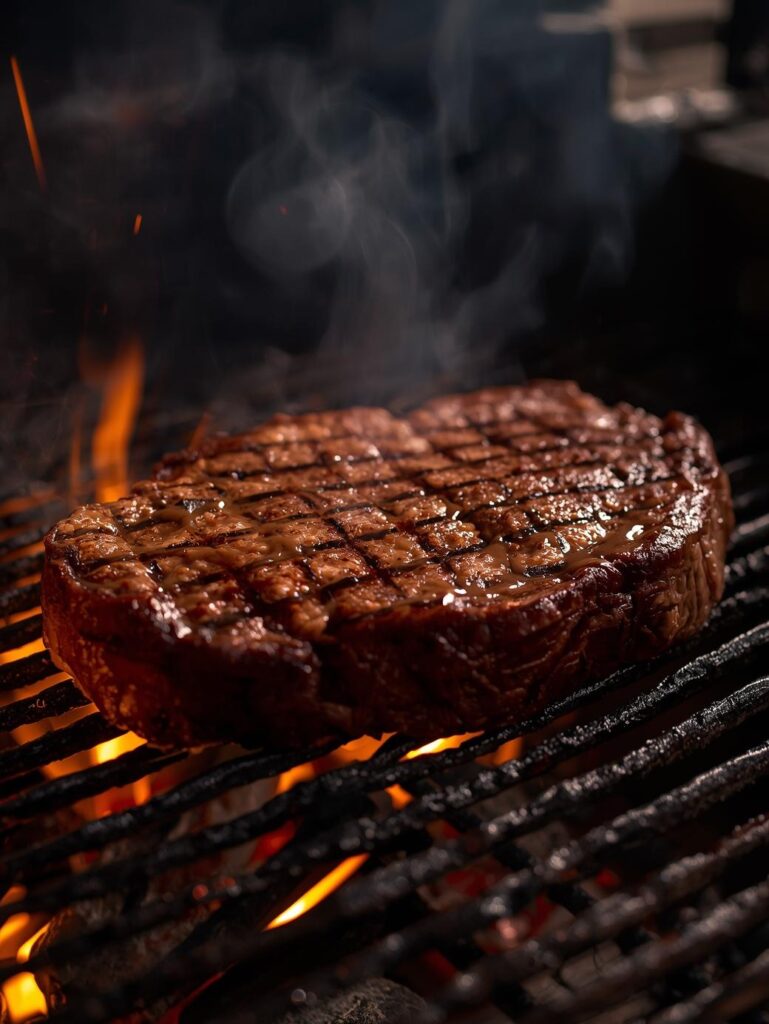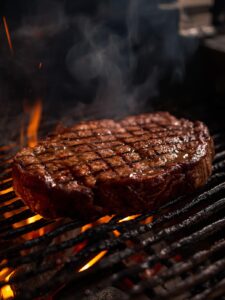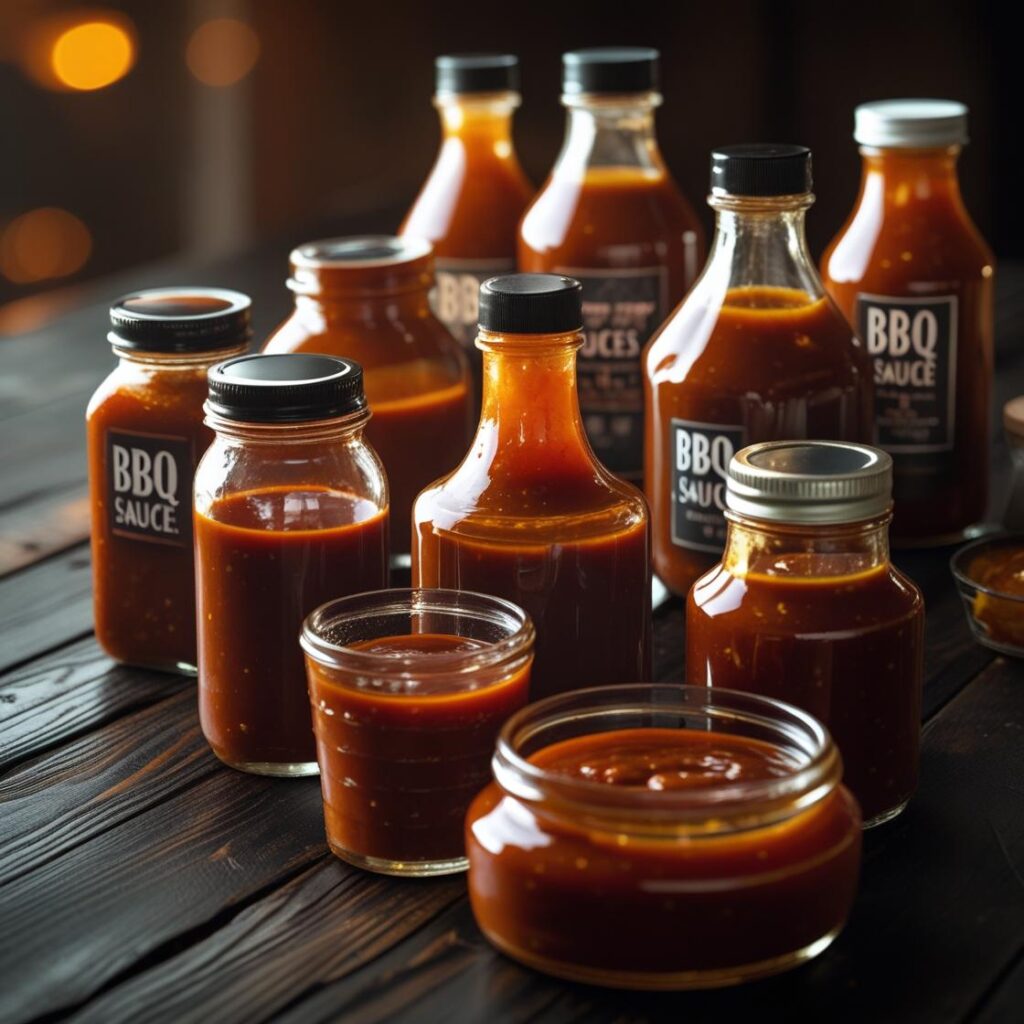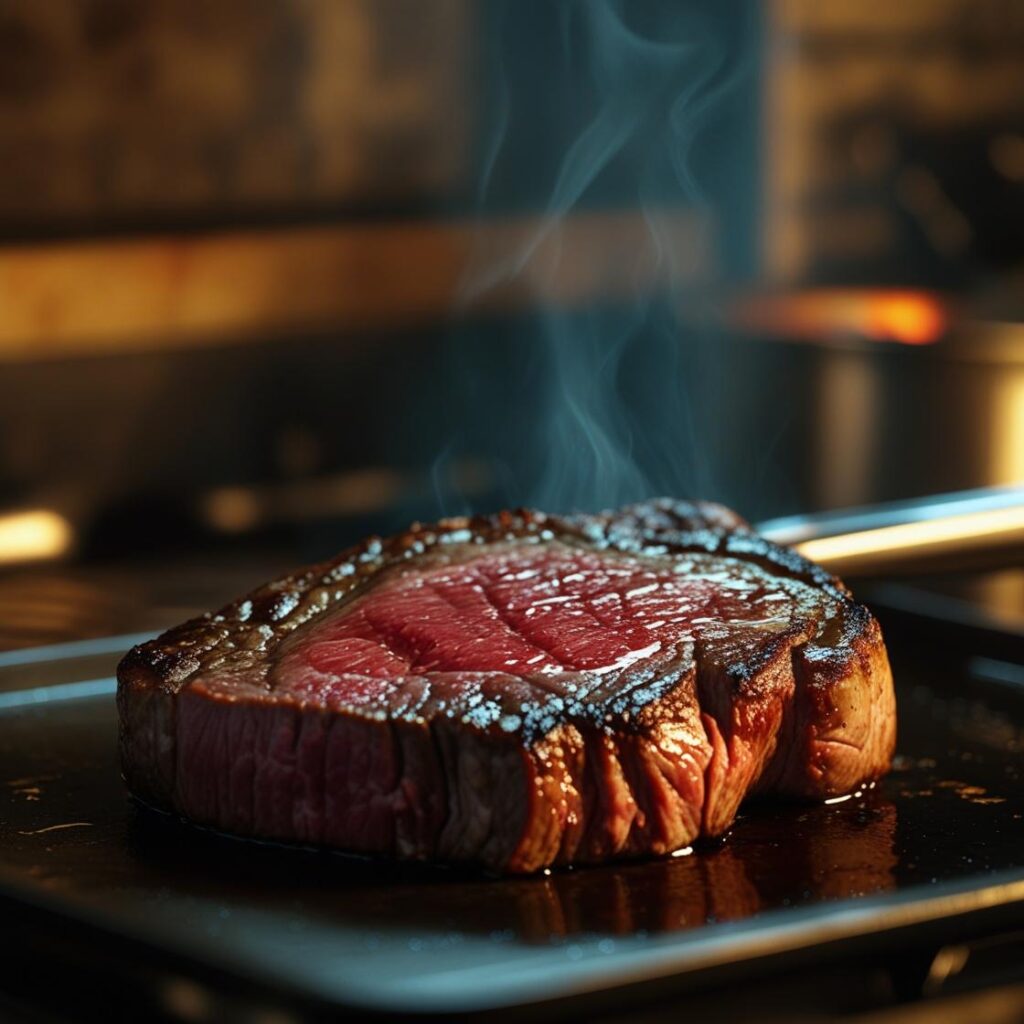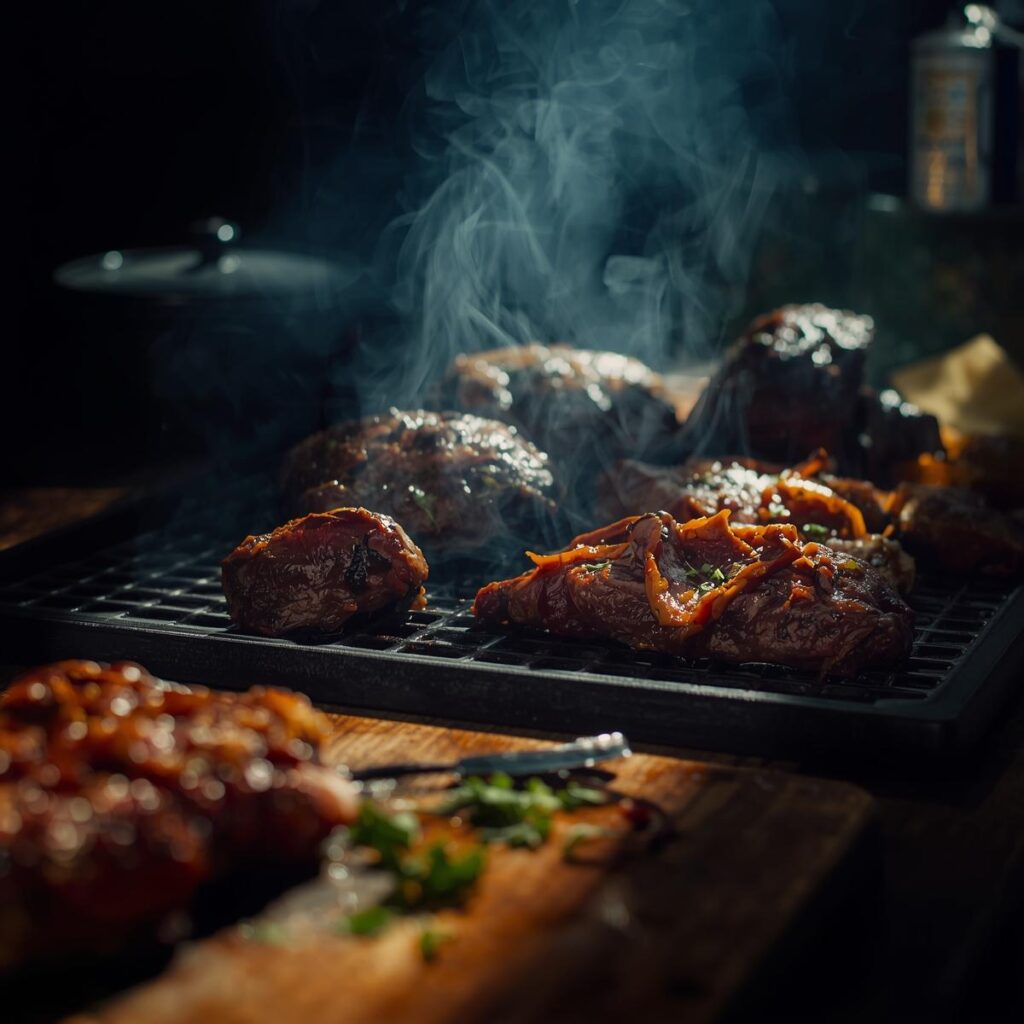Expert’s Note: This guide is part of our comprehensive BBQ Methods & Techniques Encyclopedia. Explore our complete master guide to become a true grilling expert.
10 Grilling Errors That Ruin Perfect Steak – Professional Fixes
There’s nothing quite like the sizzle of a steak hitting a hot grill. The aroma of char and seared meat promises a perfect meal—but all too often, that promise is broken. A beautiful, expensive steak can turn into a tough, dry, and disappointing experience. This frustrating outcome isn’t a matter of luck; it’s usually the result of one of a few common grilling errors. The good news is that these mistakes are easily avoidable once you know what they are.
10 Grilling Errors That Ruin Perfect Steak – Professional Fixes
10 Grilling Errors That Ruin Perfect Steak
This guide is your masterclass in grilling. We’ve compiled a list of 10 grilling errors that stand between you and a perfect steak, complete with the professional fixes you need to become a grill master. From preparation to the final rest, these grilling tips will ensure your steak is juicy, tender, and perfectly seared every single time.
New to steak grilling? Start with these essential guides:
Steak Mastery
- Steak Cuts Guide – Choose the perfect cut for grilling
- Doneness Temperatures – Master rare to well-done
- Best BBQ Steaks – Ideal cuts for grilling
- Reverse Searing Guide – Pro technique for perfect steaks
The Foundation of a Perfect Steak
Before we dive into the mistakes, remember that a great steak starts with a quality cut of meat. Choose a steak with good marbling (the little specks of fat) like a ribeye or New York strip. That fat melts as the steak cooks, adding flavor and moisture. Now, let’s get into the most common steak grilling mistakes and how to fix them.
10 Grilling Errors That Ruin Perfect Steak (and How to Fix Them)
1. Grilling a Cold Steak
One of the most common grilling errors is cooking a steak straight from the refrigerator. The cold temperature of the meat creates a major problem on the grill.
Why it happens: The outside of the steak heats up and cooks much faster than the frigid center. By the time the inside reaches a safe and delicious doneness, the exterior is often overcooked and tough.
Professional Fix: Let your steak sit out at room temperature for at least 30 minutes (for a 1-inch steak) before grilling. This allows the steak to cook more evenly from edge to center, leading to a much better result.
2. Not Patting the Steak Dry
This simple step is often overlooked, but it’s one of the most critical for achieving that beautiful, crispy crust.
Why it happens: Moisture is the enemy of searing. When a wet steak hits a hot grill, the water on the surface has to evaporate before the meat can begin to brown. This steaming process prevents the Maillard reaction—the chemical reaction that creates the rich, savory crust we all love.
Professional Fix: Before seasoning your steak, pat it completely dry on all sides with a paper towel. A dry surface allows for instant searing, creating a perfect crust in seconds.
3. Not Using High Enough Heat
Your grill needs to be hot. Really hot. If it’s not, you won’t get the sear you want, which is a major one of the steak grilling mistakes.
Why it happens: The Maillard reaction requires high heat to brown the proteins and sugars on the surface of the meat. If the grill is too cool, the steak will cook through before the crust can form, leaving you with a gray, unappealing exterior.
Professional Fix: Preheat your grill for at least 15 minutes before you start cooking. For gas grills, turn the burners to high. For charcoal grills, build a hot fire and let the coals burn until they are covered in white ash. The grill grates should be screaming hot.
4. Flipping the Steak Too Often
This is a classic rookie move that prevents a good sear from forming on either side of the steak.
Why it happens: Every time you flip the steak, you interrupt the searing process. The heat dissipates, and the crust has to start forming all over again. The result is a steak with no distinct char marks and a bland exterior.
Professional Fix: Place the steak on the hot grill and leave it alone. Let it sear for a few minutes until a beautiful crust has formed, then flip it just once to cook the other side. This one-flip technique is one of the best professional grilling fixes you can learn.
Essential Grilling Tools: Get the right equipment for perfect results:
Grill Gear Guide
- Best Thermometers – Essential for perfect doneness
- Essential BBQ Tools – Must-have grilling gear
- Grill Types Compared – Choose your perfect grill
- Top-Rated Tools – Professional equipment
5. Pressing Down on the Steak
Don’t do it! Pressing down on your steak with a spatula is a habit many people have, but it’s one of the worst grilling errors.
Why it happens: You’re literally squeezing out the meat’s precious, flavorful juices. Those juices are what keep your steak moist and tender. When they’re gone, you’re left with a dry, tough piece of meat.
Professional Fix: Never, ever press down on a steak. Let the heat from the grill do its job. The steak will naturally firm up as it cooks.
6. Using the Wrong Thermometer
Guessing when your steak is done is a surefire way to end up with a ruined dinner.
Why it happens: Relying on sight, touch, or a timer is highly inaccurate. A steak’s doneness is directly tied to its internal temperature, and an overcooked steak is one of the most common grilling errors.
Professional Fix: Invest in a high-quality instant-read thermometer. It’s the most important tool you can have in your grilling arsenal. It takes the guesswork out of grilling and ensures you hit your target temperature every single time. For more on this, read our guide on 5 doneness temperatures you need to memorize.
7. Not Accounting for Carryover Cooking
Many people pull their steak off the grill when it reaches the target temperature, but by then, it’s already too late.
Why it happens: A steak continues to cook after you remove it from the heat. The residual heat in the meat, known as “carryover cooking,” can increase its internal temperature by as much as 10 degrees. If you pull it at 135°F for medium-rare, it could end up at 145°F—a solid medium. This is a crucial concept, as we explain in our guide on 10°F Differences That Change Everything About Your BBQ.
Professional Fix: Pull the steak off the grill a few degrees before it reaches your target doneness. For medium-rare, aim to pull it off at 125-130°F (52-54°C).
8. Not Resting the Steak
This is the single most important step many people skip. It’s the final, critical piece of the puzzle.
Why it happens: When you cook a steak, the muscle fibers contract, and the juices are pushed to the center. If you cut into the steak immediately, all those juices will run out onto your cutting board, leaving you with a dry steak.
Professional Fix: After taking the steak off the grill, transfer it to a plate or cutting board and let it rest for 5-10 minutes. This allows the juices to redistribute back through the meat, resulting in a perfectly moist and tender steak. For a deeper dive into this topic, check out our guide on 3 resting mistakes that drain all juices from your steak.
9. Over-Seasoning
The goal of seasoning is to enhance the steak’s natural flavor, not to mask it.
Why it happens: Using too much salt, or a complex blend of spices, can overwhelm the delicate flavor of a good steak.
Professional Fix: Keep it simple. The only seasoning a good steak truly needs is a generous amount of coarse salt and freshly ground black pepper. Apply it right before grilling to ensure a great crust.
10. Not Cleaning the Grill Grates
Dirty grill grates are a recipe for disaster. They can lead to sticking and impart a bitter, burnt taste to your steak.
Why it happens: Old food particles and carbon buildup on the grates will stick to your new steak. They also interfere with the even heat transfer needed for a perfect sear.
Professional Fix: Always clean your grill grates before and after each use. A hot grill is easier to clean, so use a wire brush to scrape off any residue after you preheat it and again once you’ve finished grilling.
| Grilling Error | Why It Happens | Professional Fix |
|---|---|---|
| 1. Cold Steak | Uneven cooking. | Bring steak to room temp for 30 min. |
| 2. Not Patting Dry | Prevents a good sear. | Pat all sides dry with paper towels. |
| 3. Not Hot Enough Grill | No crust (Maillard reaction). | Preheat grill for at least 15 min. |
| 4. Flipping Too Often | Interrupts searing. | Flip the steak only once. |
| 5. Pressing Down | Squeezes out juices. | Never press on the steak. |
| 6. Wrong Thermometer | Inaccurate doneness. | Use a good instant-read thermometer. |
| 7. No Carryover Cooking | Steak overcooks. | Pull steak 5-10°F below target temp. |
| 8. Not Resting Steak | Juices leak out. | Rest for 5-10 minutes. |
| 9. Over-Seasoning | Masks natural flavor. | Use only salt and pepper. |
| 10. Dirty Grates | Sticking and bad flavor. | Clean grates before and after use. |
Running into grilling issues? Solve common steak problems:
Troubleshooting
- Tough Steak Fix – Solve texture problems
- Prevent Sticking – Grill surface solutions
- Common BBQ Mistakes – Avoid frequent errors
- Resting Guide – Perfect resting techniques
FAQ: 10 Grilling Errors That Ruin Perfect Steak
1. What’s the best steak to grill?
A ribeye, New York strip, or sirloin are all excellent choices. They have a good balance of fat and muscle, which makes them flavorful and tender when grilled.
2. How do I get those perfect cross-hatch marks?
To get the perfect grill marks, place the steak on the grill at a 45-degree angle. After about 2-3 minutes, turn the steak 90 degrees to create the second half of the cross-hatch. Then, flip the steak and repeat on the other side.
3. Can I use a marinade instead of seasoning?
Yes, but be careful. Many marinades are acidic, and marinating for too long can make your steak tough. For the best flavor, a dry brine with salt and a quick pan-sear is often better than a long marinade.
4. Should I close the grill lid when I cook a steak?
Closing the lid turns your grill into an oven, which can be useful for thicker steaks. For thinner steaks (under 1.5 inches), leaving the lid open can help you get a better sear.
5. What’s the biggest takeaway from this guide?
The biggest takeaway is that a thermometer is your best friend. A great steak is cooked to a specific temperature, not a specific time.
6. How do I know when my steak is done without a thermometer?
You can use the “touch test,” which involves feeling the firmness of the steak, but this method is highly inaccurate and should only be used as a last resort. An instant-read thermometer is a much more reliable tool.
7. What do you do with the leftover juices after the steak has rested?
The juices that collect on the cutting board are full of flavor. You can use them to make a quick pan sauce, or simply pour them over the sliced steak before serving for an extra layer of flavor and moisture.
Official Food Safety Resources
For official food safety guidelines and grilling best practices, consult these authoritative sources:
- USDA Safe Cooking Temperatures Official government temperature guidelines for meat safety
- FoodSafety.gov Food Safety Guide Federal food safety standards and procedures
- FDA Safe Food Handling Food and Drug Administration safety guidelines
- CDC BBQ Food Safety Center for Disease Control grilling safety tips
These external resources provide additional authoritative information on food safety standards and grilling guidelines.
Now that we’ve covered the most common questions… Let’s bring it all together with our final thoughts on mastering steak grilling.
Conclusion
Mastering how to grill a steak isn’t about natural talent; it’s about understanding and avoiding a few simple, yet critical, mistakes. By learning these professional grilling fixes, you can turn a good piece of meat into a perfect one. The difference between a tough, dry steak and a juicy, tender masterpiece is in the details. So, grab your tongs and your thermometer, and get ready to cook the best steak of your life.
Ready to Master Steak Grilling?
Join thousands of grill masters who are achieving perfect steaks every time with our proven techniques and temperature guides.
Master Grilling Techniques: Explore our complete steak and BBQ resources:
Continue Your Grilling Journey
Steak Mastery
Grilling Techniques
Equipment Guides
Problem Solving

